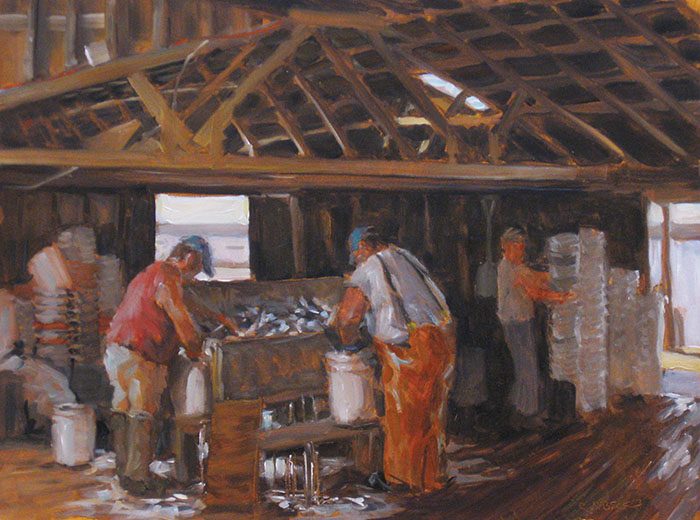Going Solo: Painting Downeast
This multi-installment feature by artist Robert Beck shares what he’s learned painting by himself along the coast of Downeast Maine. Part narrative, part instruction, and part philosophy, this first segment addresses the role of an artist and the value in painting from life. The second, appearing in Art New England’s September/October issue, discusses the practical side of painting on the road. More will follow. Each provides information to help painters grow and art patrons better understand the creative process.
Beck has painted in Maine for more than 20 years, most of which has been spent in Washington County, at the top of the Maine coast. In 2016, the Maine Maritime Museum in Bath presented a solo painting exhibition of 60 of his images, titled Over East, examining contemporary life in the Downeast fishing community.

Art as a Language
I had been painting in a small, remote Maine fishing community for weeks. Located about an hour from Canada in Washington County, the town and nearby island are made up of seven hundred households responsible for catching nearly ten million pounds of lobster a year. There were no motels, restaurants, bars, and few accommodations for visitors. The locals found it unusual to have me around, yet became used to me painting as they went about their business. I wasn’t sticking a lens in their faces and then going back to my B&B; I was setting up my French easel and working beside them, getting the same fish-squish on my boots they got on theirs.
I was three days away from the end of my trip, painting a group of women picking crabs in a building on a cove when one of them asked me where people could see my work before I left. After a brief discussion, one of them phoned the woman who organized art and music events at the small village library, and three days later, on the eve of my departure, I had my first “exhibition” in Maine. There was no advertising, just word of mouth, yet the room was full of people from the fishing community. Some had met me while I was painting, others heard from friends. One woman convinced her husband to come by telling him I was Andrew Wyeth.
We lined up my paintings along the top of the bookcases. People viewed the work and talked with each other, pointing at the images, recognizing places and people. It was their world seen through a different set of eyes. That’s part of the role of art, as it not only suggests that there is another way to look at things but implies that there are as many ways as there are people. More than that, it was validation. Naming something creates identity and worth, and helps everybody understand it and themselves better, including the artist.
That is the importance of art. It is more than decoration or daycare. It is a language with an extraordinary duality. On the one hand, art is universal. One can take a painting to Tokyo or Tulsa or Timbuktu, and it can be viewed the same way because it is built of shared understanding. Art is also a language unique to each individual artist, derived from their individual experiences, exposures, and environments. Unique to each, yet universally understood—how is that not the most powerful means we have to communicate?
There is efficiency and convenience in taking instruction, especially as a beginner. An artist needs to paint a lot to refine language and establish their personal grammar. I’ve taken classes and given them yet there is a bigger adventure to be had by packing everything you need in the trunk and taking off to give a name to the world around you. In doing so, you chronicle and inform, describing your subjects by recording what it is like for you to be there, to be present.
Art is not about duplication; it is about discovery. If you know where you will end up before you begin, the path ceases to be creative and becomes administrative. Instead, begin when you find a place to start and let it unfold as opposed to waiting for a sure thing. When something lights a flame in your belly, it’s a sign to put things in motion.
Go out and paint life from life. Describe what draws your attention. The image Shoveling Bait was painted in a shed where dock workers were unloading containers of herring into a trough, filling buckets, and lowering them down to the lobster boats that pulled up outside. The painting is composed of what I noticed and what I needed to connect those things. Nothing more.
It is up to the artist to express the gestures, action, and narrative that best describes the encounter. You could take an eighth-of-a-second slice with a camera and expect the real experience to be in there. Unfortunately, paintings of photographs most often look like paintings of photographs. A painting done from life is an interpretation expressed in your language, with adjustments made to explain the reality of that place and time. It is what matters to you, not a chip in a camera. That connection resonates with viewers, and they see it on the canvas.
